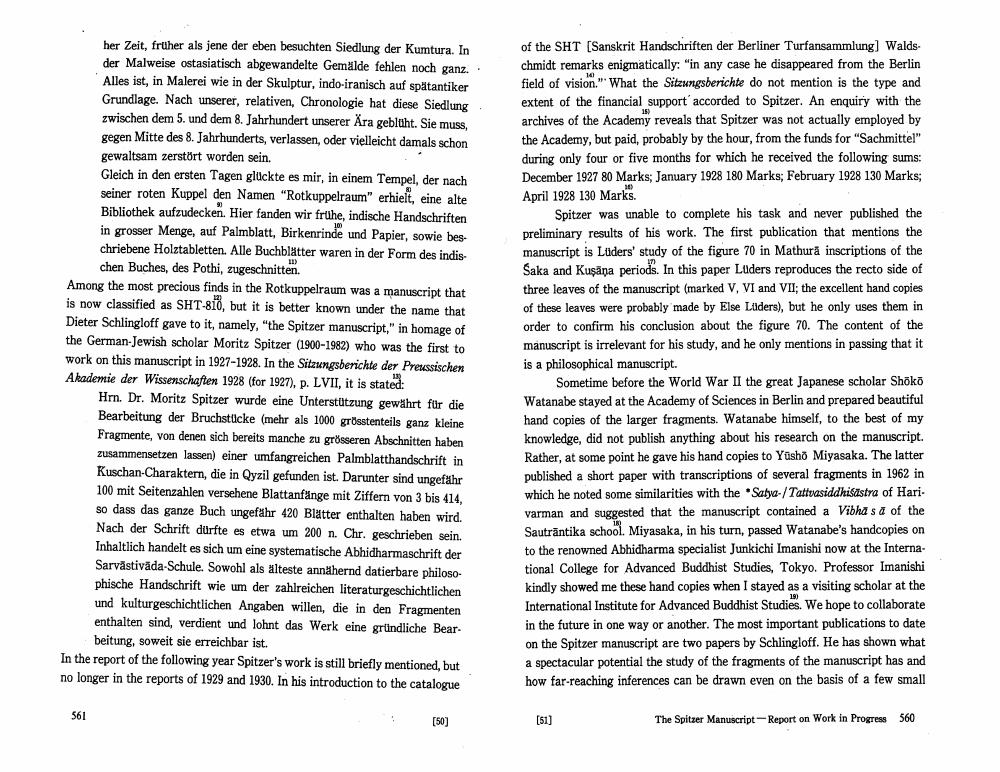Book Title: Spitzer Manuscript Report On Work In Progress Author(s): Eli Franco Publisher: Eli Franco View full book textPage 2
________________ her Zeit, früher als jene der eben besuchten Siedlung der Kumtura. In der Malweise ostasiatisch abgewandelte Gemälde fehlen noch ganz.. Alles ist, in Malerei wie in der Skulptur, indo-iranisch auf spätantiker Grundlage. Nach unserer, relativen, Chronologie hat diese Siedlung zwischen dem 5. und dem 8. Jahrhundert unserer Ara geblüht. Sie muss, gegen Mitte des 8. Jahrhunderts, verlassen, oder vielleicht damals schon gewaltsam zerstört worden sein. Gleich in den ersten Tagen glückte es mir, in einem Tempel, der nach seiner roten Kuppel den Namen "Rotkuppelraum" erhielt, eine alte Bibliothek aufzudecken. Hier fanden wir frühe, indische Handschriften in grosser Menge, auf Palmblatt, Birkenrinde und Papier, sowie beschriebene Holztabletten. Alle Buchblätter waren in der Form des indis chen Buches, des Pothi, zugeschnitten. Among the most precious finds in the Rotkuppelraum was a manuscript that is now classified as SHT-810, but it is better known under the name that Dieter Schlingloff gave to it, namely, "the Spitzer manuscript," in homage of the German-Jewish scholar Moritz Spitzer (1900-1982) who was the first to work on this manuscript in 1927-1928. In the Sitzungsberichte der Preussischen Akademie der Wissenschaften 1928 (for 1927), p. LVII, it is stated: Hrn. Dr. Moritz Spitzer wurde eine Unterstützung gewährt für die Bearbeitung der Bruchstücke (mehr als 1000 grösstenteils ganz kleine Fragmente, von denen sich bereits manche zu grösseren Abschnitten haben zusammensetzen lassen) einer umfangreichen Palmblatthandschrift in Kuschan-Charaktern, die in Qyzil gefunden ist. Darunter sind ungefähr 100 mit Seitenzahlen versehene Blattanfänge mit Ziffern von 3 bis 414, so dass das ganze Buch ungefähr 420 Blatter enthalten haben wird. Nach der Schrift dürfte es etwa um 200 n. Chr. geschrieben sein. Inhaltlich handelt es sich um eine systematische Abhidharmaschrift der Sarvästivāda-Schule. Sowohl als alteste annahernd datierbare philosophische Handschrift wie um der zahlreichen literaturgeschichtlichen und kulturgeschichtlichen Angaben willen, die in den Fragmenten enthalten sind, verdient und lohnt das Werk eine gründliche Bear beitung, soweit sie erreichbar ist. In the report of the following year Spitzer's work is still briefly mentioned, but no longer in the reports of 1929 and 1930. In his introduction to the catalogue of the SHT (Sanskrit Handschriften der Berliner Turfansammlung] Waldschmidt remarks enigmatically: "in any case he disappeared from the Berlin field of vision." What the Sitzungsberichte do not mention is the type and extent of the financial support accorded to Spitzer. An enquiry with the archives of the Academy reveals that Spitzer was not actually employed by the Academy, but paid, probably by the hour, from the funds for "Sachmittel" during only four or five months for which he received the following sums: December 1927 80 Marks: January 1928 180 Marks; February 1928 130 Marks; April 1928 130 Marks Spitzer was unable to complete his task and never published the preliminary results of his work. The first publication that mentions the manuscript is Luders' study of the figure 70 in Mathura inscriptions of the Saka and Kuşāņa periods. In this paper Luders reproduces the recto side of three leaves of the manuscript (marked V, VI and VII; the excellent hand copies of these leaves were probably made by Else Luders), but he only uses them in order to confirm his conclusion about the figure 70. The content of the manuscript is irrelevant for his study, and he only mentions in passing that it is a philosophical manuscript. Sometime before the World War II the great Japanese scholar Shöko Watanabe stayed at the Academy of Sciences in Berlin and prepared beautiful hand copies of the larger fragments. Watanabe himself, to the best of my knowledge, did not publish anything about his research on the manuscript. Rather, at some point he gave his hand copies to Yasho Miyasaka. The latter published a short paper with transcriptions of several fragments in 1962 in which he noted some similarities with the Salya-/Tattvasiddhisastra of Harivarman and suggested that the manuscript contained a Vibha sa of the Sautrāntika school. Miyasaka, in his turn, passed Watanabe's handcopies on to the renowned Abhidharma specialist Junkichi Imanishi now at the International College for Advanced Buddhist Studies, Tokyo. Professor Imanishi kindly showed me these hand copies when I stayed as a visiting scholar at the International Institute for Advanced Buddhist Studies. We hope to collaborate in the future in one way or another. The most important publications to date on the Spitzer manuscript are two papers by Schlingloff. He has shown what a spectacular potential the study of the fragments of the manuscript has and how far-reaching inferences can be drawn even on the basis of a few small 561 (50) [51] The Spitzer Manuscript - Report on Work in Progress 560Page Navigation
1 2 3 4 5 6 7 8 9 10
